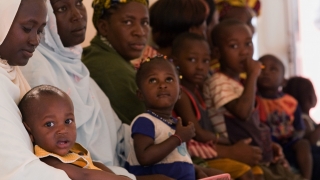Creating and developing the Research Centre to combat sickle cell disease
— Mali —

BACKGROUND
With high prevalence in the country, ranging from 4% to 25% from north to south, sickle cell disease is a particularly formidable foe in Mali. In 2005, an estimated 5,000 to 6,000 newborns have sickle cell anaemia requiring structured medical oversight. Paradoxically, local health professionals know little about this disease, one generally diagnosed too late based on its serious complications.
Fondation Pierre Fabre, having learned more about the issue from Professor Gil Tchernia and having secured the support of Professor Dapa Diallo, then head of hepatology at the Point G Hospital, decided to create a Research Centre to combat sickle cell disease (CRLD) in Bamako. The centre’s mission would be to screen for the disease, receive and hospitalise patients, conduct training and information campaigns, but also to perform clinical research. In 2006, the Foundation began bringing together the public and private partners needed to create the centre. It funded equipment purchases, arranged training for healthcare personnel, etc. Four years later, the CRLD opened in January 2010.
For the Pierre Fabre Foundation, the adventure has continued by way of two agreements covering the periods 2010-2012 and 2013-2015. It would subsidise the CRLD’s development, including training for the medical staff of care centres in Mali and the sub-region. Since 2014, the Centre has been awarding a university-level “Sickle Cell Disease” degree, one created by a 2013 decree and that 17 doctors have already obtained.
Today serving patients residing in Bamako, as well as in other Mali regions or neighbouring countries such as Guinea and Mauritania, the Bamako CRLD plays a fundamental role in the regional fight against sickle cell disease. As such, it conducts research on subjects such as the morbidity and mortality of malaria in people with sickle cell disease, or the prevalence of HIV, HBV and HCV infections and anti-Rh and Kell allo-immunization in sickle cell patients.
Lastly, an important project has been underway since 2018 to digitize the cohort’s clinical data. It will ultimately allow for better monitoring and the possibility of conducting clinical studies.
KEY FACTS
_____
Priority
Combating Sickle cell disease
Programme
Since 2006
Type of involvement
Distributor and operator
Actions
- Creation of the public and private partner consortium and overall coordination
- Funding of CRLD equipment
- Instructional design
- Training funding
- Funding for CRLD decentralisation
Research Centre to combat sickle cell disease (CRLD)
Commune III Point G
03 BP 186
BAMAKO
MALI
www.crld.sante.gov.ml
The centre’s results have shown that the extent of the disease in our country has thus far been underestimated. Fortunately, the authorities and the general population are now genuinely committed to fighting sickle cell disease in Mali. The government has been financing 80% of the centre’s annual budget since its inception.”
Pr Dapa Diallo
Professor of Haematology and Director of the Research Centre to combat sickle cell disease in Bamako
ACHIEVEMENTS AND FUTURE INITIATIVES
Achievements

12,000 +
patients followed by the CRLD by the close of 2020

100
new patients per month on average

12,730
consultations in 2020

1,978
screenings in 2020
Perspectives
Since 2018, an important project has been underway to digitize the cohort’s clinical data. It will ultimately allow for better monitoring and the possibility of conducting clinical studies.
PARTNERS
During creation of the project:
- Association malienne de lutte contre la drépanocytose – AMLUD (information campaign funding, fundraising)
- Conseil général des Hauts-de-Seine (funding for centre construction)
- Fondation Caisses d’Épargne pour la Solidarité (funding of training and information initiatives)
- Fondation pour l’Enfance (funding for staff)
- François Depresle (architectural design of the centre)
- Gil Tchernia (scientific expertise)
- Mali’s Government (land donation, provision of medical staff, generics supplies)
Since creation of the project:
- Coopération internationale de la Principauté de Monaco (screening and treatment funding)
- Ministère des Affaires étrangères (funding for an International Technical Expert position on temporary assignment to Prof. Diallo)
See also
Support for the Sickle Cell Research and Treatment Centre (CRTD)
The Fondation Pierre Fabre has been supporting the Bangui Sickle Cell Research and Treatment Centre (CRTD) since 2019. The CRTD is the country’s only referral institution and receives financial support for training and purchasing medicines and equipment.30/07/2025See also
Supporting the fight against sickle cell disease in Sub-Saharan Africa
This multi-country project must address the major challenge of reducing morbidity and mortality linked to sickle cell disease by acting on several levels: Detect, treat, train, raise awareness and support public authorities30/07/2025Follow our actions
The Global South E-Health Observatory launches its 2026 call for project proposals!
Join the community of ODESS award winners and contribute to the digital transformation of healthcare in the low-middle-income countries!





